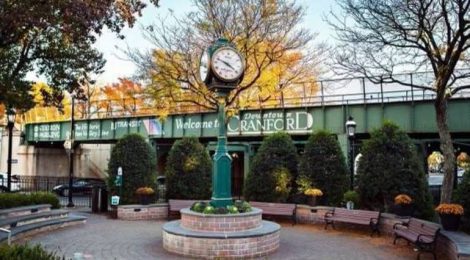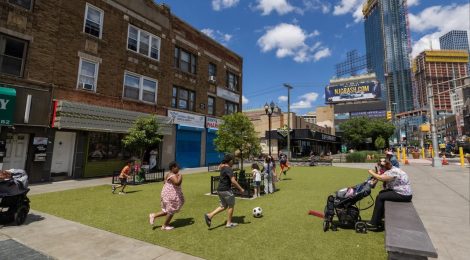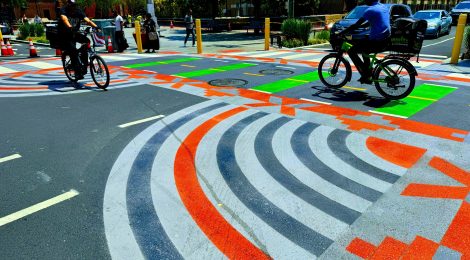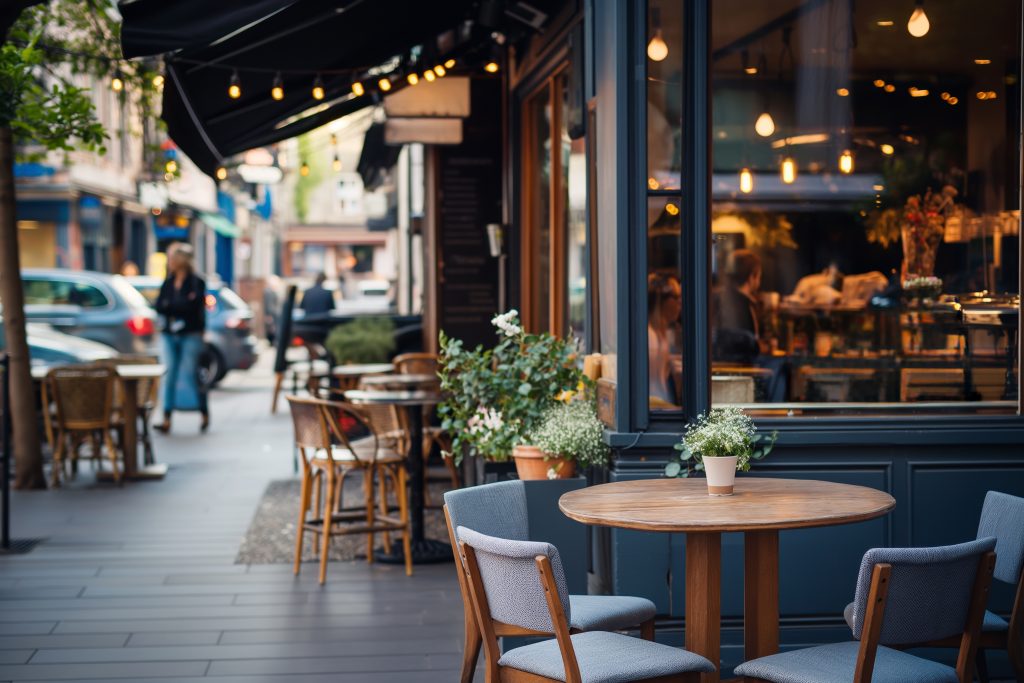The Role of SIDS in Creating Defining Public Spaces
By Gabe Bailer
NJ Urbanthinker
February 19, 2025
Public spaces play a vital role in downtown areas by providing places where people can gather, interact, relax, and participate in various activities. These spaces come in many forms, with common examples including parks, plazas, and streets designed to encourage interaction, walkability, and a sense of community. Such spaces often serve as defining features of a community, fostering economic investment and playing a central role in revitalization efforts.
Many downtowns are fortunate to already have public spaces woven into their community fabric and built environment. However, some downtowns lack these defining spaces, missing out on the positive benefits and sense of place they bring. So how can new public spaces be created? The process typically involves multiple steps, including planning, design, community engagement, funding, and construction. This journey requires a clear vision, time, collaboration, and financial resources, making it a challenging path to navigate. As a result, many envisioned public spaces never become reality.
Creating new public spaces in downtown areas demands vision, advocacy, and collaboration to drive the process forward. But who takes on this responsibility? If your downtown has a Special Improvement District (SID), it can play a crucial role in facilitating this process. SIDs are often instrumental in brokering partnerships, navigating challenges, communicating with stakeholders, and securing the necessary funding to bring a new public space to life.
What is a SID
Many of you may already know what a Special Improvement District (SID) is, but for those who don’t, here’s an overview. A SID is a public-private partnership between a municipality and property owners within a defined area. In most cases, a SID is a nonprofit organization, though in some instances, it operates as a municipal department.
SIDs provide a wide range of services with the overarching goal of fostering economic revitalization and enhancing the area they serve. These services often include beautification efforts, such as landscaping and installing street furniture, designing and improving public spaces, supporting business development, ensuring public safety, and maintaining clean streets. Additionally, SIDs organize programming and events, spearhead placemaking initiatives, develop branding and marketing strategies, manage social media accounts, and promote the area to attract investment and engagement.
SIDs also act as a unified voice for businesses and property owners in their district, advocating for policies and initiatives that benefit the community. In short, SIDs are essential in driving the growth, vitality, and appeal of their designated areas.
How are SIDs funded?
 SIDs are primarily funded through assessments or fees collected from property owners within the defined SID area. These assessments provide the financial support needed for the SID’s day-to-day operations. Typically, the assessment amount is based on the property’s value, although other factors, such as square footage, can also influence the calculation.
SIDs are primarily funded through assessments or fees collected from property owners within the defined SID area. These assessments provide the financial support needed for the SID’s day-to-day operations. Typically, the assessment amount is based on the property’s value, although other factors, such as square footage, can also influence the calculation.
To enhance their funding, SIDs often engage in additional fundraising efforts. These may include seeking sponsorship opportunities and applying for grants from local, state, or federal programs. Such supplemental funding allows SIDs to expand their operations, introduce new programs, and develop innovative marketing initiatives to benefit the district.
The Roles SIDs in Creating Defining Downtown Public Spaces
 A SID is deeply embedded in the community, with a thorough understanding of the businesses, residents, and visitors that contribute to its vibrancy. This unique position enables a SID to identify and envision opportunities for new public spaces, such as transforming parking lots or vacant lots into vibrant gathering places or retrofitting and rehabilitating existing public spaces.
A SID is deeply embedded in the community, with a thorough understanding of the businesses, residents, and visitors that contribute to its vibrancy. This unique position enables a SID to identify and envision opportunities for new public spaces, such as transforming parking lots or vacant lots into vibrant gathering places or retrofitting and rehabilitating existing public spaces.
SIDs can garner community support and provide valuable data and metrics to assess the need for new or improved public spaces. Through surveys, polls, and insights shared on social media, they can gauge public interest and gather feedback. Additionally, SIDs can lay the groundwork for new public spaces by hosting pop-up events or offering temporary programming in potential locations. For existing spaces, they can make incremental improvements, such as adding street furniture or landscaping. These initiatives serve as “test runs” to evaluate whether a new public space or enhancements will drive positive engagement and usage.
When the results are favorable, a SID can advocate on behalf of the community, acting as a bridge between residents, municipal governments, and elected officials to navigate the process of creating or improving public spaces. Furthermore, SIDs can provide funding for plans and designs, leveraging these resources to apply for grants, initiate fundraising efforts, and secure matching funds from local governments. By serving as intermediaries between businesses and community groups, SIDs play a critical role in coordinating the development and enhancement of public spaces, ensuring their success and alignment with community needs.
Examples of Public Spaces Where SIDs Played a Role in Shaping
 Downtown Cranford became New Jersey’s first SID with its establishment in 1985. Recognizing the importance of placemaking, streetscape improvements, design, and public space, the SID partnered with the planning firm Wallace, Todd, and Roberts to create a design manual. This manual laid the groundwork for the transformation of a parking lot, which had occupied the heart of downtown Cranford for over 70 years, into the vibrant Eastman Clock Plaza—a centerpiece of the community.
Downtown Cranford became New Jersey’s first SID with its establishment in 1985. Recognizing the importance of placemaking, streetscape improvements, design, and public space, the SID partnered with the planning firm Wallace, Todd, and Roberts to create a design manual. This manual laid the groundwork for the transformation of a parking lot, which had occupied the heart of downtown Cranford for over 70 years, into the vibrant Eastman Clock Plaza—a centerpiece of the community.
Downtown Cranford used the design manual to establish clear guidelines and develop concept plans for Eastman Clock Plaza. From there, the SID took the project from concept to reality, coordinating local efforts to secure funding and spearheading fundraising initiatives. These efforts resulted in the creation of a thriving public space that now serves as the heart of Downtown Cranford.
Without the planning, vision, and leadership provided by the SID, Eastman Clock Plaza might have remained a simple parking lot instead of the vibrant community hub it is today. This transformation showcases the critical role a SID can play in revitalizing and reimagining public spaces.
 Bergen Square Plaza, located in the Journal Square neighborhood of Jersey City, is one of the oldest public plazas in the state. Its origins date back to 1660, when Dutch settlers established a town square in the area. In recent years, the City of Jersey City embarked on a project to reimagine this historic space, transforming two parking lots into a vibrant public plaza that now serves as an integral part of the Journal Square neighborhood.
Bergen Square Plaza, located in the Journal Square neighborhood of Jersey City, is one of the oldest public plazas in the state. Its origins date back to 1660, when Dutch settlers established a town square in the area. In recent years, the City of Jersey City embarked on a project to reimagine this historic space, transforming two parking lots into a vibrant public plaza that now serves as an integral part of the Journal Square neighborhood.
This transformation was made possible through a public-private partnership led by Jersey City’s Infrastructure Department, in collaboration with the Journal Square SID and the Bergen Square Committee. Construction of the new Bergen Square Plaza was completed in July 2024. The space now features green areas, street furniture for public use, green infrastructure, and raised intersections to enhance pedestrian safety. Additionally, the plaza honors its historical roots with elements like historic pavement patterns and interpretive signage.
The Journal Square SID played a key role in the community planning process, gathering input from local businesses and residents to shape the plaza’s design. Moving forward, the SID will oversee the maintenance, care, and management of Bergen Square Plaza, ensuring it remains clean, inviting, and well-maintained for public enjoyment.
 As Chris Bernando, Administrator for the Journal Square SID, explained: “The importance of maintaining a public space cannot be understated. In fact, the City’s confidence in the Journal Square SID to manage the plaza after construction significantly influenced the final design. With our staff and resources, we are committed to the long-term upkeep of Bergen Square Plaza, ensuring the public investment made by the City continues to benefit the community.”
As Chris Bernando, Administrator for the Journal Square SID, explained: “The importance of maintaining a public space cannot be understated. In fact, the City’s confidence in the Journal Square SID to manage the plaza after construction significantly influenced the final design. With our staff and resources, we are committed to the long-term upkeep of Bergen Square Plaza, ensuring the public investment made by the City continues to benefit the community.”
A SID can play a crucial role in planning, guiding, listening, shaping, funding, and programming public spaces. If your community is fortunate enough to have a SID, chances are it has been instrumental in shaping the public spaces that contribute to the neighborhood’s vibrancy and sense of place.
Gabe Bailer, PP, AICP is a project manager with Harbor Consultants a boutique planning and engineering company in Cranford. Gabe also manages his blog NJ Urbanthinker where his random planning ideas come to fruition.


